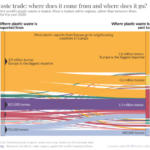House Built From Rubbish 🏡 – Is Plastic Waste Acceptable As A Building Material?
Energy Disrupter
House Built From Rubbish 🏡: What if we start creating our homes mainly using recycled plastic? Innovators proved that it’s already possible, but will it be sustainable in the future? Or, are there any dangers involved?
A couple of years ago, the concept of recycling was taken to a crazy whole new level. That is, amazingly, the thinking that born the Waste House located at the University of Brighton. I, for one, definitely found it amazing that they created a house built from rubbish by using over 85 per cent of waste materials collected from various domestic establishments and building sites. It really gave ‘sustainable’ a whole new meaning!
>Download Now: Free PDF Business Owners Guide To Commingled Recycling Bin Services
The lingering plastic problem’s solution?
As we all know, the global plastic problem has been going on for quite a few decades already. As plastics increase, so does landfills, pollution and global warming, even. Australians, in particular, produce around 660 thousand tonnes of plastic every year. As a result, solutions were conceptualised and executed, with the house built from rubbish used as an example above.
Nowadays, we do think of utilising plastic (i.e., recycling it) instead of disposing of it in landfill and incinerating it – houses built from this mentioned plastic rubbish might be the solution.
I know you have quite a lot of questions in regards to this topic. So, we here at Waster will hopefully help you form an idea of your own whether or not to use plastic rubbish as a building material. Read on to learn more.
Meanwhile, check out our newly-uploaded video on Youtube tackling the topic of carbon-neutral waste collection. Subscribing to our official channel will surely be appreciated!
[embedded content]
A bit about Waster
Before we go further discussing the potential of houses built from rubbish, let us first share Waster.
We here at Waster provide you with innovative solutions for your business’s waste management and recycling needs. Moreover, we provide flexible, 30-day contracts instead of the typical lock-in contracts, which proves to be better.
Click on the blue button to learn more.
READ: Newtown Garbage Collection 🗑️
The reasons why houses should be built from plastic rubbish
We have already seen recycled plastic’s utilisation on construction aside from houses – for example, plastic roads. In Queensland, scientists of James Cook University made people gasp with amazement when they created and used concrete made from recycled plastic – not using the usual concrete wire mesh.
As far as we’re concerned, it would also be a great idea to create houses built from recycled plastic rubbish. Australians can enjoy its benefits if it indeed does become the norm in the near future. This leads us to one of our main questions: what benefits can we enjoy when we build houses using recycled plastic materials? Below, we state some of its benefits:
- Houses built from plastic rubbish can promote the saving of the environment. As stated above, the global plastic problem lingers up until this day. A huge amount of plastic go to landfills and get incinerated, which causes quite an environmental problem. Recycling plastics to be used to create roads and houses is a good solution, as it reduces our environmental impact.
- Plastic is a very versatile material with very redeeming features. It is lightweight, easily moulded, heavily protected against chemicals, heat-resistant (e.g., polypropylene), cold-resistant, useful as electrical insulators and durable – desirable features for construction materials. Furthermore, it needs less water to absorb when added to concrete.
- It can help save money. Lightweight materials like recycled plastic generally cost less than the typical concrete for material building such as cement, so expect to spend less when building with plastic rubbish. Additionally, moving plastic rubbish to and from different points is easier and more efficient, so transportations costs are also cut down.
‘Lego’ build some houses!
Colombia has long started the ‘house built rubbish’ innovation to tackle their plastic problem, all the while providing homes for thousands of homeless people. They did this using the Lego building model.
Conceptos Plasticos, a company based in Bogota, aims to turn something bad into good by using the plastic we think of as a deterrent to a pollution-free and sustainable world and transform it into something which we need to progress to become more earth-friendly.
It is worth noting that house-building in the centre area of the country in which Colombian musician Fernando Llanos, who inspired the house built from rubbish idea, is difficult to access. So, using the versatile and easily-transferred plastic in producing bricks was the best idea they could come up with.
The team designated to build the houses built from rubbish finishes them fast, too. It only takes up to 5 days (sometimes even 4) before a house can go up. Moreover, a mere 4 people without building experience managed to successfully erect the house within the said timeframe. The 40 square metre model home has 2 divided bedrooms, a bathroom, a kitchen and a dining room.
Are there problems in creating houses built from rubbish?
We might think of using recycled plastic to create homes as the best, green solution to deal with the plastic problem we have at hand. However, remember that nothing comes without risks. TPM Builders presented a good argument in regards to this.
The first thing that comes to mind, of course, is its longevity. Will a house built from mainly plastic rubbish last a long time? 500 years (the time it takes for plastic to degrade) down the line, what will happen to the microparticles? They may merge with the soil and water and produce leachate (highly contaminated liquid caused by decomposition – mainly occurs in landfills), which will harm the environment.
The fact of the matter is that the development is fairly recent, so we should give it time before considering it as the norm in construction.

House built from rubbish: conclusion
We are certainly ecstatic to see more developments on recycled rubbish being used as construction materials for houses (and roads) in the future. But as we have stated, more research and implementations should be done, considering that it is a fairly new innovation.
Additional things you need to know about Waster
If you’re looking for recycling bins, check our waste recycling shop and find the best deals in terms of pricing and services.
Also, please call 1300 WASTER (1300 927 837), or email us at [email protected] if you have any further questions.

















